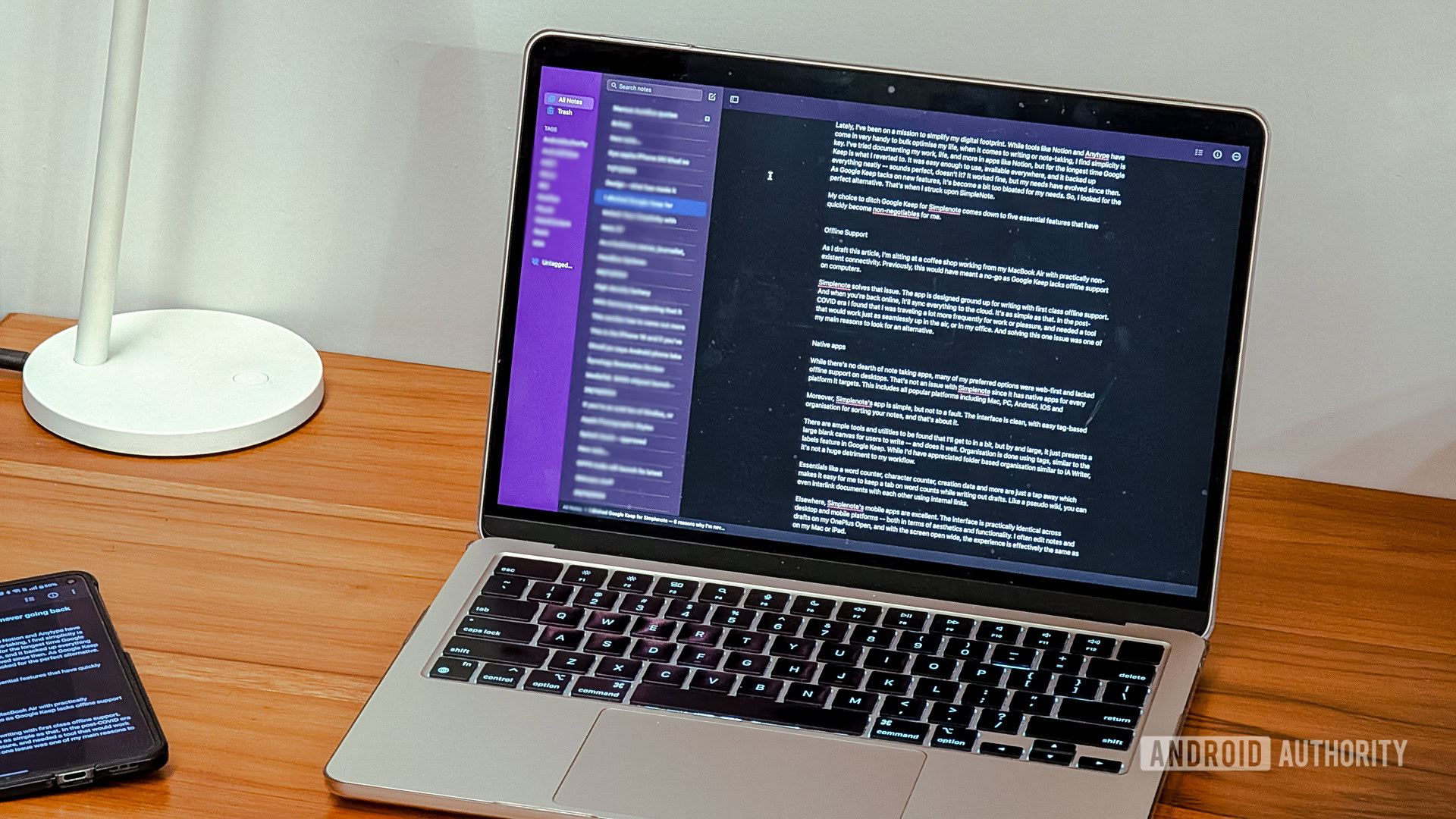
Dhruv Bhutani / Android Authority
Lately, I’ve been on a mission to simplify my digital footprint. While tools like Notion and Anytype have come in handy to bulk optimize my life, I find simplicity is key when it comes to writing or note-taking. I’ve tried documenting my work, life, and more in some of the best diary and journal apps like Notion, but I reverted to Google Keep for the longest time. It was easy enough to use, available everywhere, and it backed up everything neatly — sounds perfect, doesn’t it?
It worked fine, but my needs have evolved since then. As Google Keep tacks on new features, it’s become a bit too bloated for my needs, and the interface’s lack of focus on long-form writing started irking me. So, I looked for the perfect alternative. That’s when I struck upon SimpleNote.
Is Google Keep your primary note-taking app?
0 votes
Some of you might suggest that I should’ve looked at Google Docs as the obvious upgrade from Google Keep. However, every time I entertained that idea, I always landed on six essential features that made Simplenote a non-negotiable upgrade for me.
Offline support
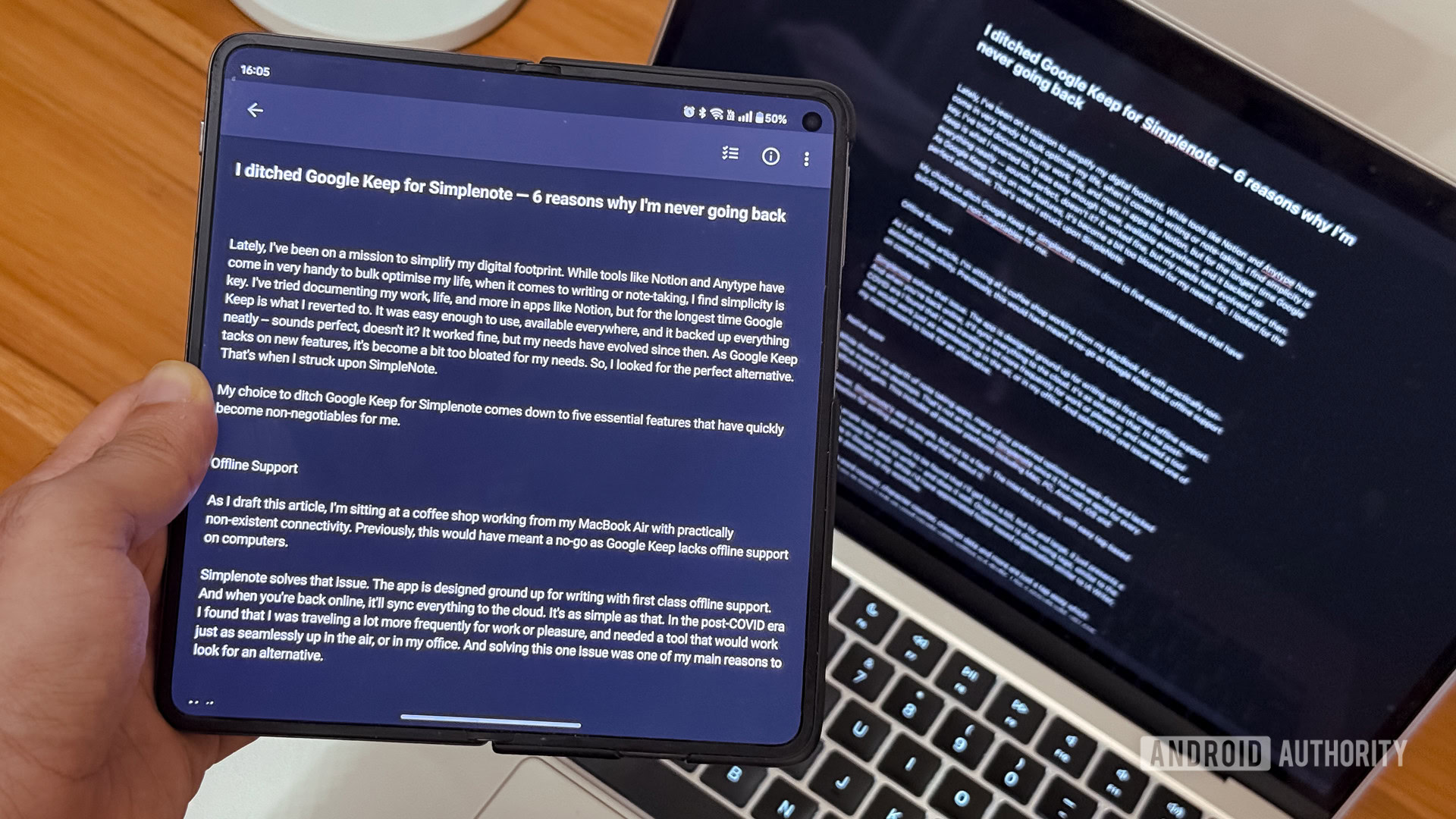
Dhruv Bhutani / Android Authority
As I draft this article, I’m sitting at a coffee shop working from my MacBook Air with practically non-existent connectivity. Previously, this would have meant a no-go as Google Keep lacks offline support on computers.
Up in the air, or at a cafe with limited connectivity, Simplenote lets me continue my work.
Simplenote solves that issue. The app is designed from the ground up for writing with first-class offline support. When you’re back online, it’ll sync everything to the cloud. It’s as simple as that. In the post-COVID era, I found that I was traveling a lot more frequently for work or pleasure and needed a tool that would work just as seamlessly up in the air or in my office. Solving this one issue was one of my main reasons to look for an alternative.
Native apps
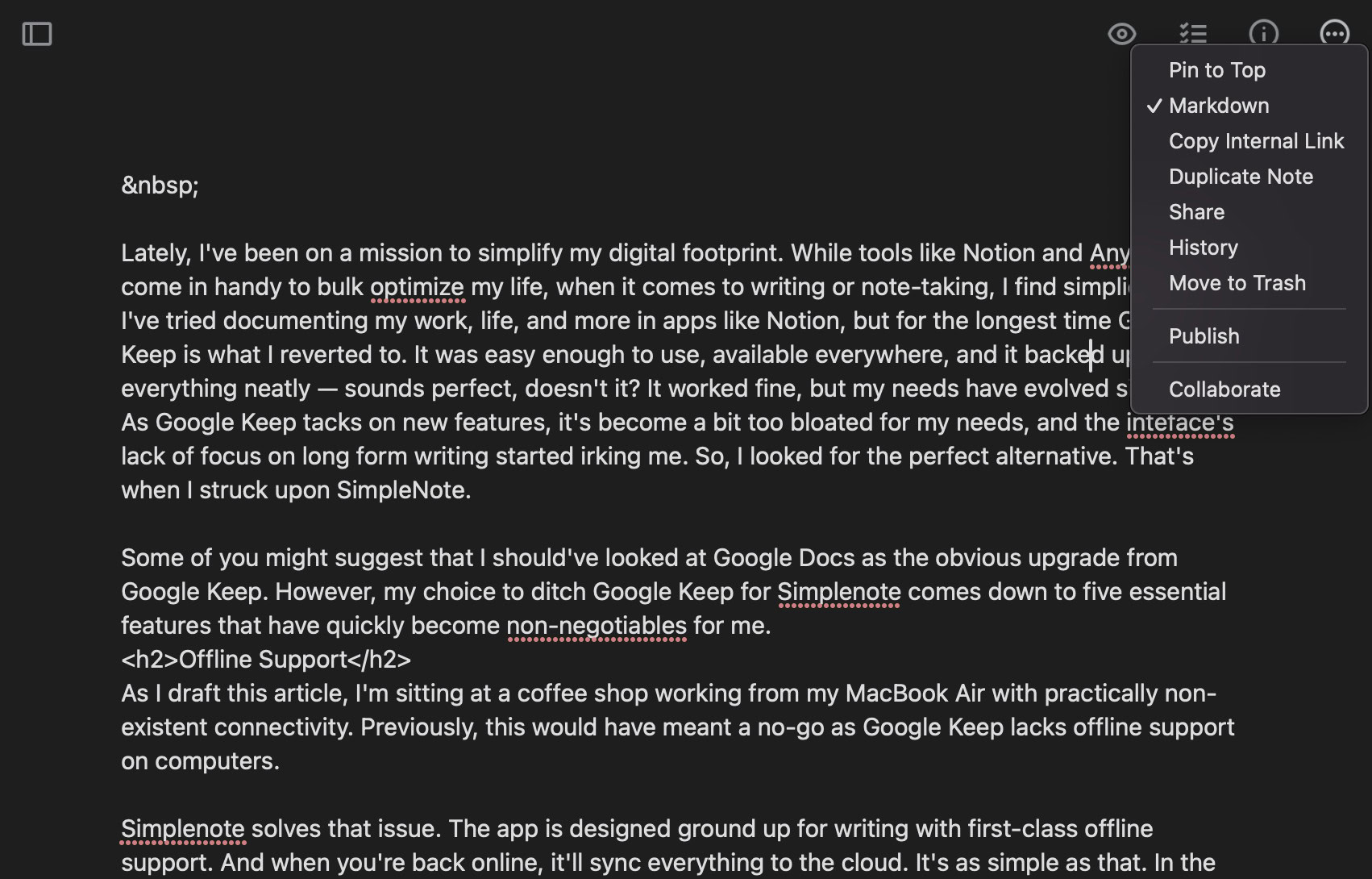
Dhruv Bhutani / Android Authority
While there’s no dearth of note-taking apps, many of my preferred options were web-first and lacked offline support on desktops. That’s not an issue with Simplenote since it has native apps for every platform it targets. This includes all popular platforms, including Mac, PC, Android, iOS, and web.
Moreover, Simplenote’s app is simple, but not to a fault. The interface is clean, with easy tag-based organization for sorting your notes, and that’s about it.
There are ample tools and utilities to be found that I’ll get to in a bit, but by and large, it just presents a large blank canvas for users to write — and does it well. Organization is done using tags, similar to the labels feature in Google Keep. While I’d have appreciated folder-based organization similar to iA Writer, it’s not a huge detriment to my workflow.
Simplenote is simple to use but has all the essential features.
Essentials like a word counter, character counter, creation data, and more are just a tap away which makes it easy for me to keep a tab on word counts while writing out drafts. Like a pseudo wiki, you can even interlink documents with each other using internal links.
Elsewhere, Simplenote’s mobile apps are excellent. The interface is practically identical across desktop and mobile platforms — both in terms of aesthetics and functionality. I often edit notes and drafts on my OnePlus Open, and with the screen open wide, the experience is effectively the same as on my Mac or iPad.
Additionally, I love how quickly Simplenote synchronizes files. All changes are reflected in near real-time, and if you have the app open on your phone while working on a computer, you can see the words pop up moments after you type them out. This gives me additional peace of mind that my notes are being safely backed up.
Markdown support
If you’re unaware of markdown, you’re in for a treat. The markup language makes it easy to write fully formatted text in a plain-text editor. Think using an asterisk for italics, and double asterisk for bold. It even makes it easy to define headline sizes. This text is easily transportable across apps and tools while retaining its formatting.
Markdown support makes it a breeze to move notes between apps and content management services.
As Simplenote supports Markdown, I can write out my draft copy to my liking, copy and paste it to a CMS, or copy it over to an app like Obsidian for archival purposes. It’s great and essential for a user like me who moves across multiple content management systems and tools daily.
Collaboration and publishing

Dhruv Bhutani / Android Authority
Hidden behind that barebones interface is a surprisingly robust feature set. Like Google Keep, you can add collaborators to your notes. It is as easy as tagging users by their email address, and they’ll be invited to the note. From there on, both users will be able to work on the document. It’s almost like Google Docs but much more straightforward and, dare I say, cleaner.
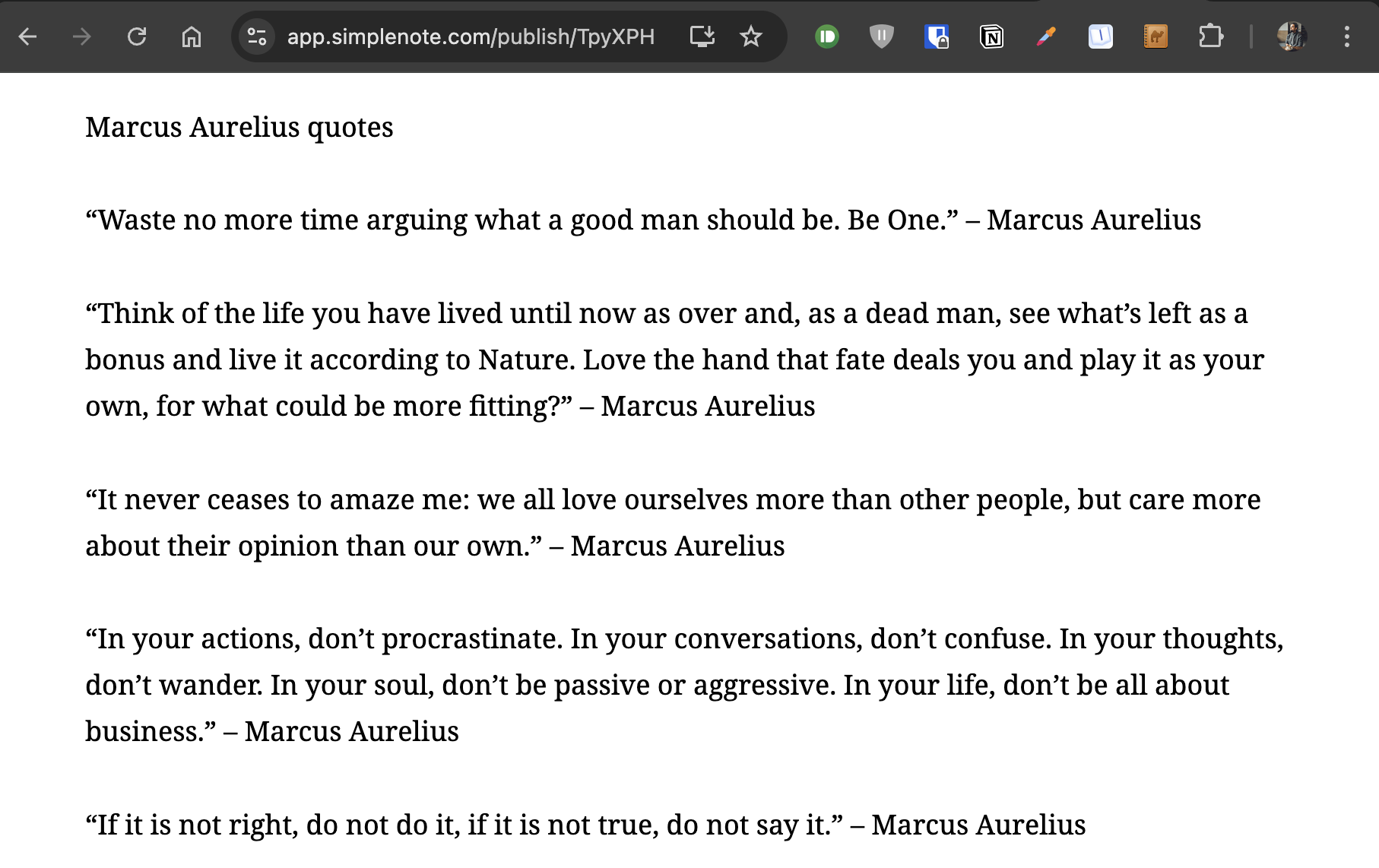
Dhruv Bhutani / Android Authority
Additionally, there’s one more feature that I find very handy. Just like Notion, Simplenote lets you publish notes on the web. So, for example, if you want to share a shopping list or something you wrote without giving readers the ability to edit it, Simplenote will let you publish it as a web page. I maintain a list of interesting quotes I’ve come across while reading and have it published on the internet for anyone to read. You can check it out here.
Easy export
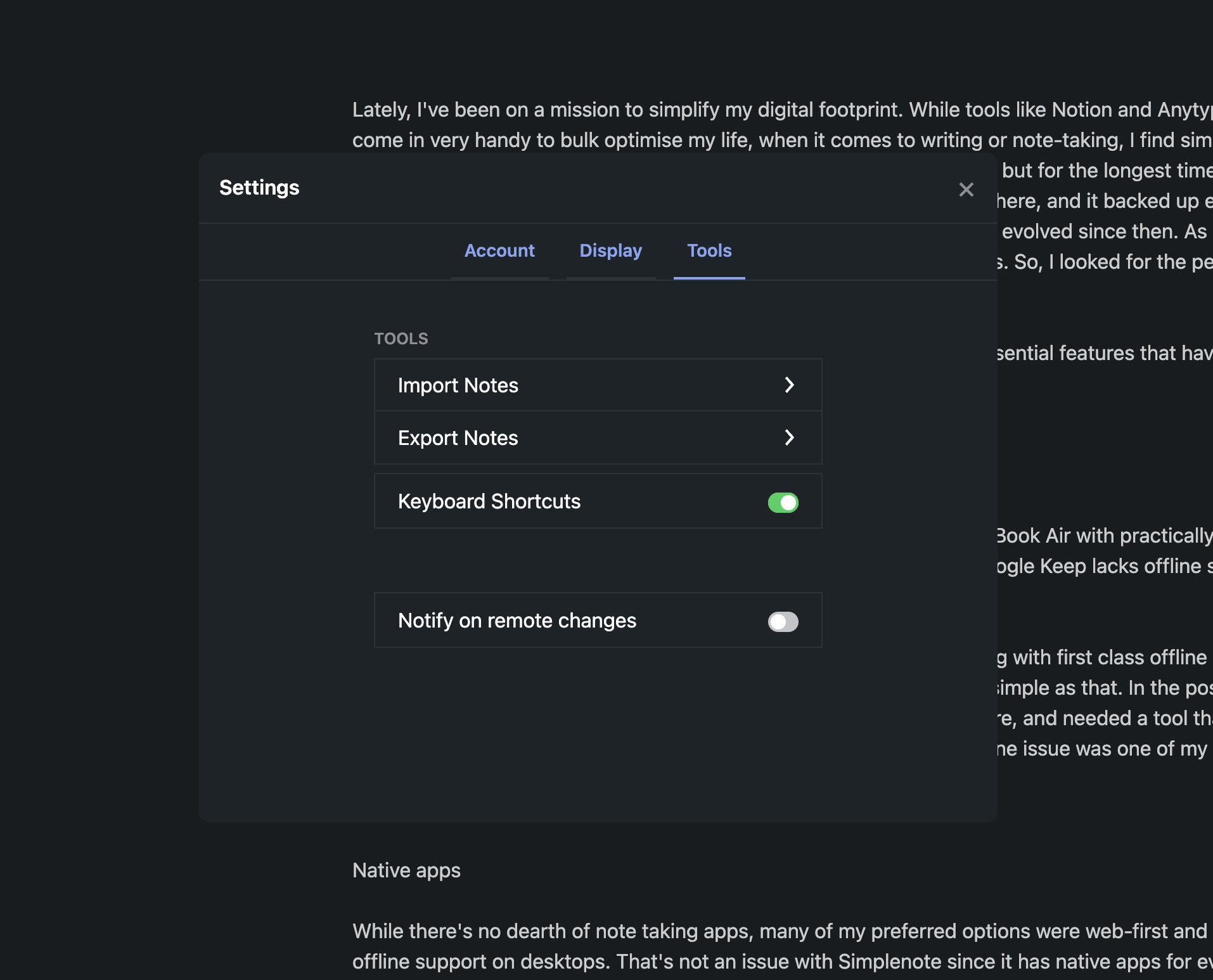
Dhruv Bhutani / Android Authority
I’ve talked about it multiple times, but the ability to move my data is critical to me every time I commit to an app. In fact, I seriously considered splurging a nosebleed amount on iA Writer for its local markdown files support. Even though Simplenote doesn’t let you access individual note files on your computer, exporting all your notes and files is a two-step process.
These individual markdown files can then be comfortably imported into any other note-taking or productivity app, where they will maintain all formatting and tags.
Free
I’m not averse to subscription services, or apps with a one-time fee — within reason. Before settling on Simplenote, I spent a lot of time testing out iA Writer. As good as the app is, I couldn’t get myself to pay $50 per platform in addition to a subscription on Android. Simply put, a hundred dollars and a subscription fee is a lot of money to pay for a note-taking app.
Barring a few quality-of-life features, Simplenote offers a very similar experience to paid apps for free. What's not to like?
So for me, there’s a clear winner in the Google Keep vs. Simplenote battle. I’ve been using Simplenote as my primary note-taking platform for well over a year now, and it has never failed me. The app is clean, consistently keeps my notes in sync, and I can easily move the unformatted text to any other app of my choice. Sure, it misses out on features like background colors or the ability to insert images, but I don’t miss those at all. Simplicity and a pure writing experience are why I shifted to a dedicated note-taking app, and Simplenote delivers that in spades.







 English (US) ·
English (US) ·